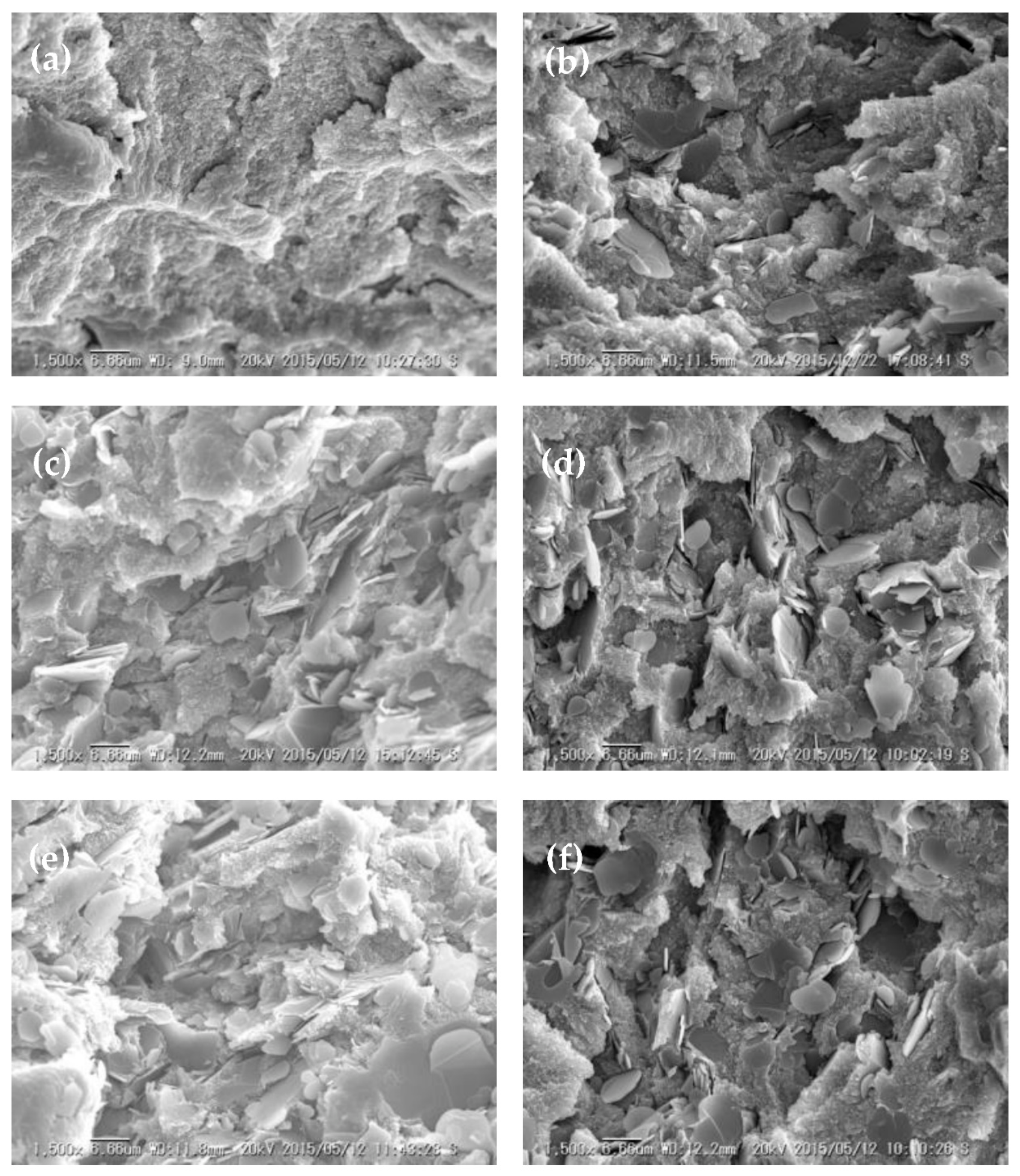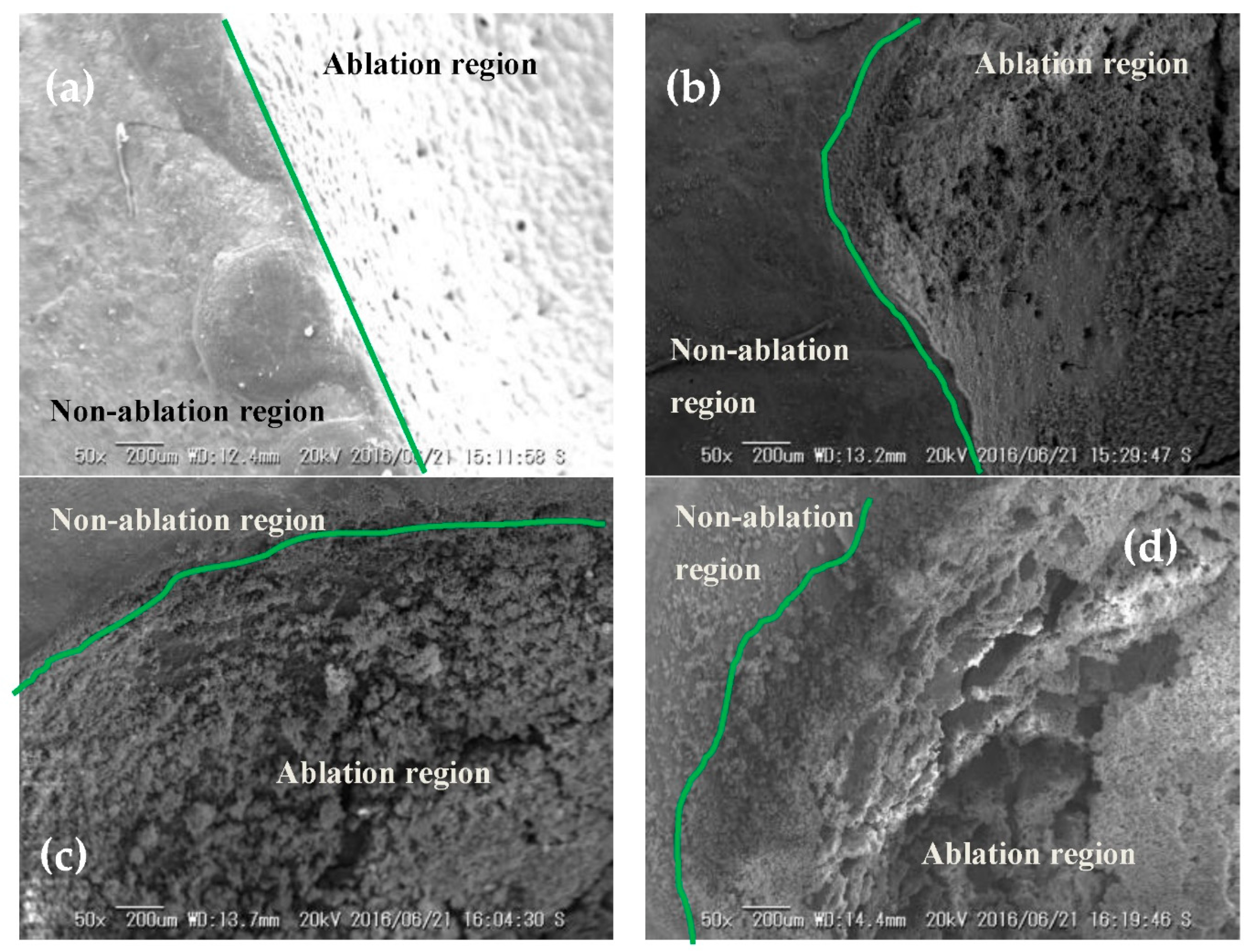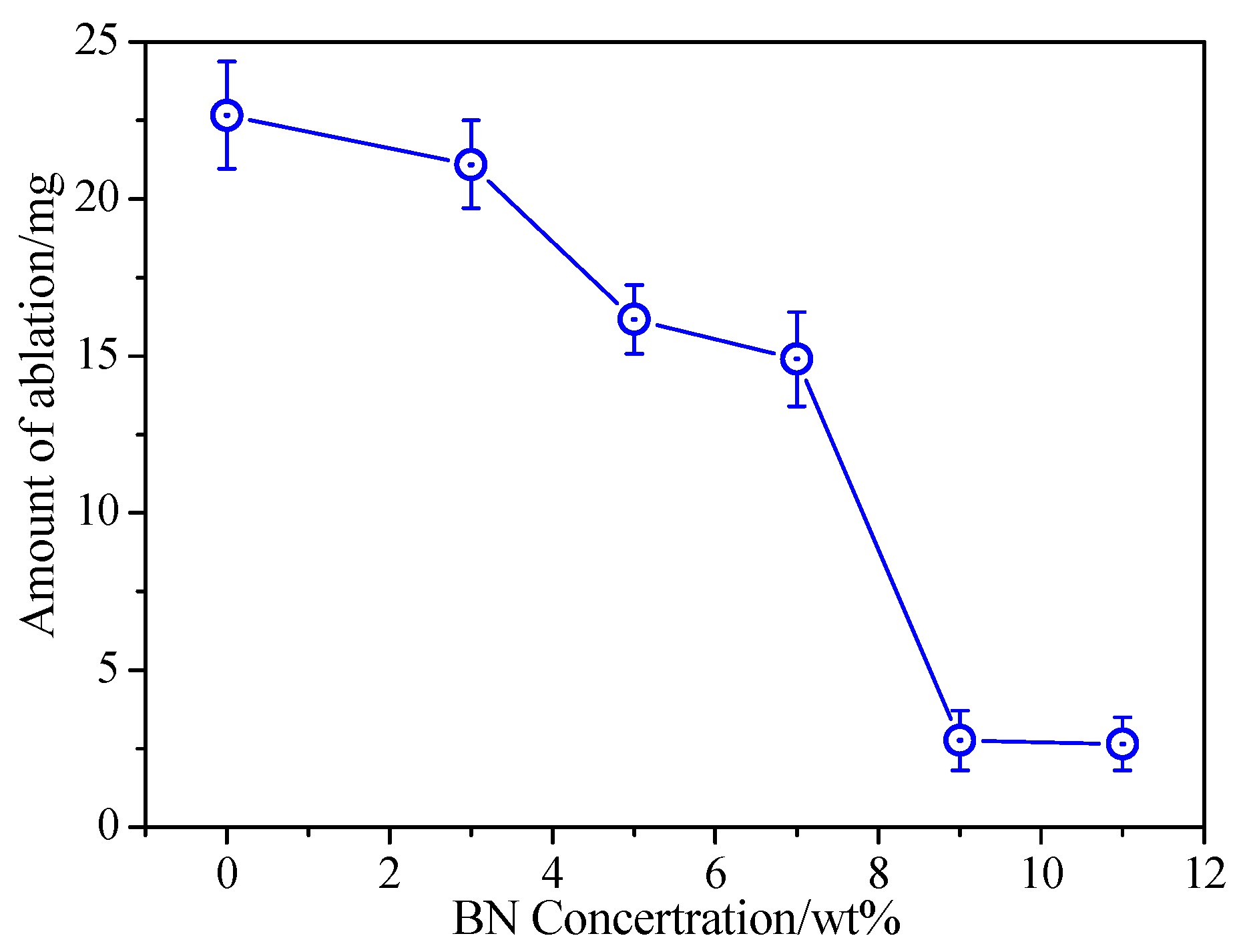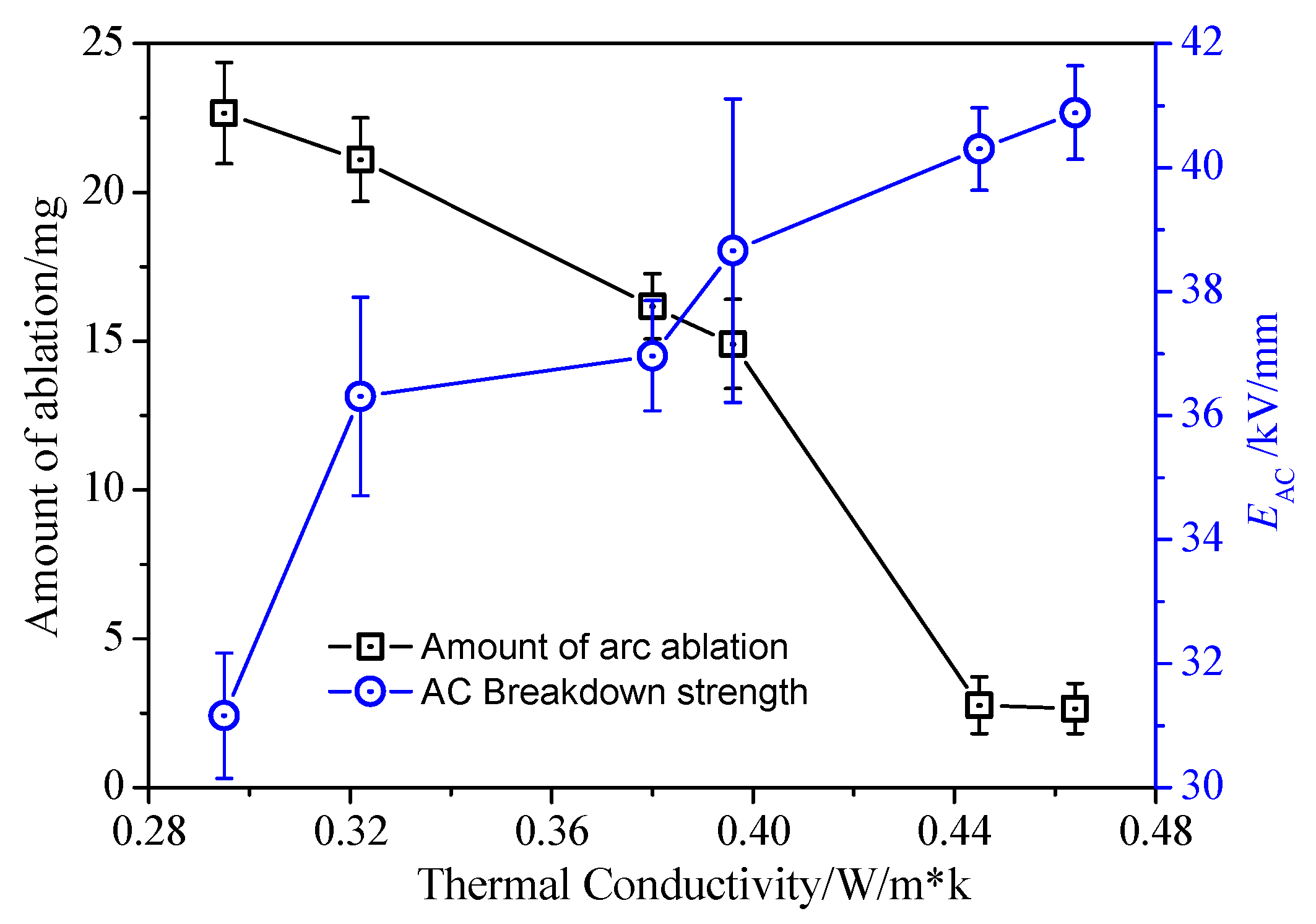Arc Ablation Resistance and Dielectric Strength Properties of PTFE/BN Composites
Abstract
:1. Introduction
2. Experimental Section
2.1. Preparation of PTFE/BN Specimens
2.2. Characterization of PTFE/BN Composites
3. Experimental Results
3.1. SEM Characterization
3.2. Thermal Transport Properties
3.3. Spectral Reflectance Properties
3.4. Surface Sediment Properties
3.5. Arc Ablation Properties
3.6. AC Breakdown Performances
4. Discussion
5. Conclusions
Author Contributions
Funding
Institutional Review Board Statement
Informed Consent Statement
Conflicts of Interest
References
- Huang, D.; Shu, Y.; Ruan, J.; Hu, Y. Ultra High Voltage Transmission in China: Developments, Current Status and Future Prospects. Proc. IEEE 2009, 97, 555–583. (In Chinese) [Google Scholar] [CrossRef]
- Verma, A.R.; Reddy, B.S. Evaluation of ceramic insulators for UHVDC transmission. IEEE Trans. Dielectr. Electr. Insul. 2018, 25, 38–45. [Google Scholar] [CrossRef]
- Wang, Z.; Yu, Q.; Mou, Y.; Ji, Y.; Hu, J.; Chen, S.; He, J. Analysis and mitigation of low-frequency resonance in a long-distance UHVDC ± 1100 kV system. Electr. Power Syst. Res. 2018, 162, 118–124. [Google Scholar] [CrossRef]
- Shu, Y.; Zhang, W. Research of Key Technologies for UHV Transmission. Proc. CSEE 2007, 27, 1–6. (In Chinese) [Google Scholar]
- Li, Y.; Zhao, M.; Zhou, Q.; Geng, B. Research on Arc Ablation Resistance of PTFE Improved by Introducing Inorganic Filler. In Proceedings of the 2008 International Symposium on Electrical Insulating Materials, Yokkaichi, Japan, 7–11 September 2008; pp. 7–11. [Google Scholar]
- Zhang, J.L.; Yan, J.D.; Murphy, A.; Hall, W.; Fang, M.T.C. Computational investigation of arc behavior in an auto-expansion circuit breaker contaminated by ablated nozzle vapor. IEEE Trans. Plasma Sci. 2002, 30, 706–719. [Google Scholar] [CrossRef]
- Yan, J.; Fang, T.; Liu, Q. Dielectric breakdown of a residual SF/sub 6/ plasma at 3000 K under diatomic equilibrium. IEEE Trans. Dielect. Elect. 1997, 4, 114–119. [Google Scholar] [CrossRef]
- Sato, M.; Horinouchi, K.; Hiza, S.; Nakamura, Y. Ablated mass of PTFE nozzle due to high-current SF6 arc exposure: Formulation of ablated mass. Electr. Eng. Japan. 2019, 208, 29–38. [Google Scholar]
- Petchanka, A.; Reichert, F.; Gonzalez, J.-J.; Freton, P. Modelling of the deformation of PTFE-nozzles in a high voltage circuit breaker due to multiple interruptions. J. Phys. D Appl. Phys. 2016, 49, 135201. [Google Scholar] [CrossRef]
- Seeger, M.; Tepper, J.; Christen, T.; Abrahamson, J. Experimental study on PTFE ablation in high voltage circuit-breakers. J. Phys. D Appl. Phys. 2006, 39, 5016–5024. [Google Scholar] [CrossRef]
- He, J.; Wang, K.; Li, J. Application of an Improved Mayr-Type Arc Model in Pyro-Breakers Utilized in Superconducting Fusion Facilities. Energies 2021, 14, 4383. [Google Scholar] [CrossRef]
- Eichhoff, D.; Kurz, A.; Kozakov, R.; Gött, G.; Uhrlandt, D.; Schnettler, A. Study of an ablation-dominated arc in a model circuit breaker. J. Phys. D Appl. Phys. 2012, 45, 305204. [Google Scholar] [CrossRef]
- Wang, C.; Ding, H.; Wang, H. Thermodynamic Model and Dynamic Temperature Compensation in Positive-Pressure-Based Sonic Nozzle Gas Flow Standard. IEEE Trans. Instrum. Meas. 2013, 62, 1154–1165. [Google Scholar] [CrossRef]
- Reichert, F.; Gonzalez, J.-J.; Freton, P. Modelling and simulation of radiative energy transfer in high-voltage circuit breakers. J. Phys. D Appl. Phys. 2012, 45, 375201. [Google Scholar] [CrossRef]
- Pawar, S.; Sharma, A. Multiphysics Simulation of Welding-Arc and Nozzle-Arc System: Mathematical-Model, Solu-tion-Methodology and Validation. J. Inst. Eng. (India) Ser. C 2019, 100, 145–152. [Google Scholar] [CrossRef]
- Nie, Y.; Yang, L.; Han, Y.; Li, S. Effect of BN size on arc ablation characteristics of PTFE material. In Proceedings of the International Conference on Condition Monitoring and Diagnosis (CMD), Xi’an, China, 25–28 September 2016; pp. 499–502. [Google Scholar]
- Nie, Y.; Yang, L.; Han, Y.; Li, S. Effect of BN size on AC breakdown performances of PTFE/BN composites. In Proceedings of the International Conference on Electrical Materials and Power Equipment (ICEMPE), Xi’an, China, 14–17 May 2017; pp. 635–638. [Google Scholar]
- Kowalski, L.; Duszczyk, J.; Katgerman, L. Thermal conductivity of metal powder-polymer feedstock for powder injection moulding. J. Mater. Sci. 1999, 34, 1–5. [Google Scholar] [CrossRef]
- El-Broloss, T.; Ibrahim, S. Photoacoustic measurement of thermal properties of polystyrene metal oxide composites. Thermochim. Acta 2010, 509, 46–49. [Google Scholar] [CrossRef]
- Yang, H.; Chen, Q.; Chi, H.; Zhang, J.; Wang, X. Dielectric and Thermal Conductivity Characteristics of Epoxy Res-in-Impregnated H-BN/CNF-Modified Insulating Paper. Polymers 2020, 12, 2080. [Google Scholar] [CrossRef]
- Yung, K.C.; Liem, H.; Choy, H.S. Prerequisite for maximizing thermal conductivity of epoxy laminate using filler. J. Mater. Sci. Mater. Electron. 2012, 24, 1095–1104. [Google Scholar] [CrossRef]
- Song, W.-L.; Wang, P.; Cao, L.; Anderson, A.; Meziani, M.J.; Farr, A.J.; Sun, Y.-P. Polymer/Boron Nitride Nanocomposite Materials for Superior Thermal Transport Performance. Angew. Chem. Int. Ed. 2012, 51, 6498–6501. [Google Scholar] [CrossRef]
- Cheng, W.-C.; Hsieh, Y.-T.; Liu, W.-R. Enhanced Thermal Conductivity of Silicone Composites Filled with Few-Layered Hexagonal Boron Nitride. Polymers 2020, 12, 2072. [Google Scholar] [CrossRef]
- Raza, M.A.; Westwood, A.; Brown, A.; Stirling, C. Performance of graphite nanoplatelet/silicone composites as thermal interface adhesives. J. Mater. Sci. Mater. Electron. 2012, 23, 1855–1863. [Google Scholar] [CrossRef]
- Li, W.; Feng, W.; Huang, H. High-performance epoxy resin/silica coated flake graphite composites for thermal conductivity and electrical insulation. J. Mater. Sci. Mater. Electron. 2016, 27, 6364–6370. [Google Scholar] [CrossRef]
- Wilbers, A.; Kroesen, G.; Timmermans, C.; Schram, D. The continuum emission of an arc plasma. J. Quant. Spectrosc. Radiat. Transf. 1991, 45, 1–10. [Google Scholar] [CrossRef] [Green Version]
- Swartz, E.; Pohl, R. Thermal Boundary Resistance. Rev. Mod. Phys. 1989, 61, 605–668. [Google Scholar] [CrossRef]
- Zhou, W.; Yu, D.; Wang, C.; An, Q.; Qi, S. Effect of filler size distribution on the mechanical and physical properties of alumina-filled silicone rubber. Polym. Eng. Sci. 2008, 48, 1381–1388. [Google Scholar] [CrossRef]
- Qiu, Y.; Liang, J. Thermal conductivity of PP/Al(OH)3/Mg(OH)2 composites. Compos. Part B Eng. 2013, 44, 248–252. [Google Scholar]
- Oomori, T.; Hamano, S.; Sasao, H.; Ueda, Y. Optical Observation of Self-Gas-Flow in GCB. IEEE. Trans. Power. Appar. Syst. 1983, 3, 1408–1413. [Google Scholar]
- Moon, P.H. The Theory of Thermal Breakdown of Solid Dielectrics. Trans. Am. Inst. Electr. Eng. 1931, 50, 1008–1021. [Google Scholar] [CrossRef]
- Ieda, M. Dielectric Breakdown Process of Polymers. IEEE Trans. Electr. Insul. 1980, EI-15, 206–224. [Google Scholar] [CrossRef]
- Donnay, M.; Tzavalas, S.; Logakis, E. Boron nitride filled epoxy with improved thermal conductivity and dielectric breakdown strength. Compos. Sci. Technol. 2015, 110, 152–158. [Google Scholar] [CrossRef]
- Huang, L.; Lv, X.; Tang, Y.; Ge, G.; Zhang, P.; Li, Y. Effect of Alumina Nanowires on the Thermal Conductivity and Electrical Performance of Epoxy Composites. Polymers 2020, 12, 2126. [Google Scholar] [CrossRef] [PubMed]









Publisher’s Note: MDPI stays neutral with regard to jurisdictional claims in published maps and institutional affiliations. |
© 2021 by the authors. Licensee MDPI, Basel, Switzerland. This article is an open access article distributed under the terms and conditions of the Creative Commons Attribution (CC BY) license (https://creativecommons.org/licenses/by/4.0/).
Share and Cite
Zhao, X.; Nie, Y.; Zhao, T.; Wang, K.; Song, B.; Yu, S.; Li, S. Arc Ablation Resistance and Dielectric Strength Properties of PTFE/BN Composites. Energies 2021, 14, 6705. https://doi.org/10.3390/en14206705
Zhao X, Nie Y, Zhao T, Wang K, Song B, Yu S, Li S. Arc Ablation Resistance and Dielectric Strength Properties of PTFE/BN Composites. Energies. 2021; 14(20):6705. https://doi.org/10.3390/en14206705
Chicago/Turabian StyleZhao, Xianping, Yongjie Nie, Tengfei Zhao, Ke Wang, Bingchen Song, Shihu Yu, and Shengtao Li. 2021. "Arc Ablation Resistance and Dielectric Strength Properties of PTFE/BN Composites" Energies 14, no. 20: 6705. https://doi.org/10.3390/en14206705
APA StyleZhao, X., Nie, Y., Zhao, T., Wang, K., Song, B., Yu, S., & Li, S. (2021). Arc Ablation Resistance and Dielectric Strength Properties of PTFE/BN Composites. Energies, 14(20), 6705. https://doi.org/10.3390/en14206705





